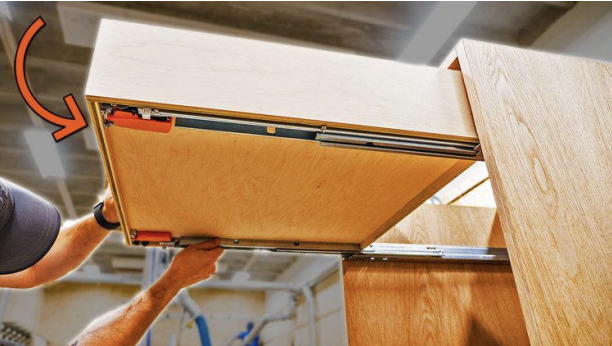ALL ABOUT DRAWERS
Installation Guide
CABINET DRAWERS
Kitchen cabinet drawers are one of the most, if not the most, used components of any kitchen. Stop!…Think back to how often you open and shut a drawer while you’re getting dinner ready or you’re searching for that specific item in the “junk drawer”or whatever the case may be. It’s a lot more than you thought, right? That’s why it’s important to under- stand all of the features and options there are when it comes to the construction of the cabinet drawers. Below we’ll outline everything you need to know about drawers, from the basic terms and construction of them to the repairing of existing drawers to fully replacing the drawer itself. By the end of this you’ll feel confident in deciding what types of drawers you want when choosing your new set of used kitchen cabinets.
ANATOMY OF A CABINET DRAWER
DRAWER BOX
DRAWER FRONT
DRAWER GLIDES OR SLIDES
- Slide Mounted
Ball Bearing Glides
Ball Bearing Glides
are made with steel ball bearings that roll in a thin track. This allows the drawer to move in and out smoothly with less friction. These slides can hold a fair amount of weight, are inexpensive, and are easy to install. On the downside the ball bearing can get gummed up by dirt and dust fairly easily. Some people also don’t like the glide being visible.

- UNDERMOUNT GLIDES


- ROLLER GLIDES OR EURO SLIDES
DRAWER PULL
JOINTS
- STAPLED JOINTS


- DOVETAILED JOINTS
DRAWER MOTIONS
- STAPLED JOINTS
- STAPLED JOINTS
- PUSH-TO-OPEN
CABINET DRAWER REPAIRS
There are 3 common ways that drawers tend to break down: 1) the bottom panel of the drawer bulges out, 2) the front panel of the drawer becomes loose, damaged, or falls off, or 3) the drawer glides become worn out. Below we’ll go over how to fix those types of defects yourself. If the drawer is damaged more than that it may make more sense to just order a new box or drawer front or both. We’ll show that below as well. Before starting any repairs always double check that it’s not something as simple as tightening some screws on the glides.
FIXING A BROKEN DRAWER FRONT
1
Start by removing the screws that attached the drawer front to the drawer box. These will be located inside the drawer box.
2
3
If the damage was just a matter of it coming off the drawer box, then the drawer front will need new pilot holes and fasteners to re-secure it properly.
4
Start by using a 3/16th drill bit to drill new pilot holes next to the original holes of just the drawer box. NOT THE DRAWER FRONT
5
If the original screws are still usable then go ahead use them to reattach the drawer front to the drawer box using the new pilot holes.
** If you need new screws then order them here Wood Screws | The Home Depot or you can take your original screws into any hardware store and they’ll help you match your particular screw.
REPLACING BALL BEARING GLIDES (SLIDES)
1
2
3
4
5
INSTALLING UNDERMOUNT GLIDES
1
2
3
4
5
BUYING A DRAWER REPLACEMENT
You're All Set!
Not only have you saved money, but you saved another beautiful cabinet draw set from ending up in the landfill.
want to remember this DIY Installation Guide? Download it here. Completely free
